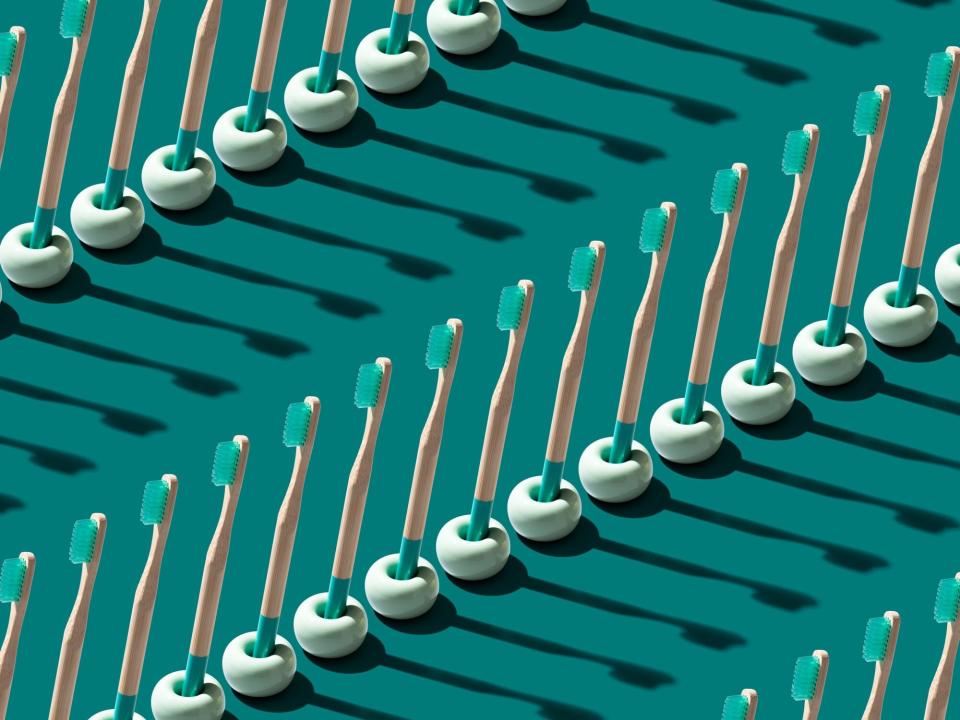This Is How Often You Need to Get a New Toothbrush, According to Dentists
A toothbrush is one personal care item that you should definitely replace on a regular basis. Why? Because your mouth is home to some 700 species of microbes, or germs like bacteria and fungus, which amounts to roughly six billion different bacteria. In fact, your oral microbiome is the second largest and most diverse after your gut microbiome. And like the microbial makeup of your gut, some types of bacteria that live in your mouth are the good guys, taking care of business when it comes to digestion, cleanliness, fresh breath, and more (counterintuitive, but true!). But some other bacteria aren't quite so helpful, and your toothbrush can easily get loaded with millions of germs.
You want to be hygienic without being unnecessarily wasteful—so how often should you really swap out for a new toothbrush? We asked dentists how long you can go before replacing a used toothbrush, how to tell if it's time to toss yours, and if there's anything you can do in between to keep those bristles clean.

Mirage C/Getty Images
RELATED: Here's the Right Way to Floss That'll Make Your Next Trip to the Dentist More Pleasant
How often should you replace your toothbrush?
Three to four months for manual toothbrushes.
The American Dental Association recommends replacing your manual toothbrush every three to four months—but not stretching it past six months. "People should replace their toothbrush at a minimum of every six months," confirms LaQuia A. Walker Vinson, DDS, MPH, a board-certified specialist in pediatric dentistry. Your toothbrush quite literally brushes bacteria off of your teeth, and any germs can stick around even after you've rinsed off post-brush. Plus, worn out toothbrushes don't remove plaque well, so you'll want to swap it regularly in order to give your teeth and gums the good cleanings they deserve.
One to two months for electric toothbrushes.
Electric toothbrush heads, on the other hand, may need to be replaced even sooner. "With electric toothbrushes, the time is typically shorter, about one to two months," says Thomas McCarthy, DDS. "Electric toothbrushes vibrate at high speeds and the brush heads don't last as long as standard toothbrushes."
ASAP if you've been sick.
Dr. Vinson does say, however, if you've been sick with a cold, flu, or other virus or infection, it's important to toss your toothbrush and grab a new one right away once you've recovered—even if you're nowhere near the three-to-four-month mark.
RELATED: Should You Brush Your Teeth Before or After Breakfast?
Other Signs You Need to Replace Your Toothbrush
Depending on the type of toothbrush you have, it may give you some telltale signs that it's overdue for replacement. "If the bristles start to bend and curve up, it is definitely time," Dr. Vinson says. According to a 2013 study, bristle flaring actually makes your toothbrush less effective after 40 days of consistent use.
Some brushes are made with specific technology to signal that they've past their prime. "Many toothbrushes have built-in indicators that change over time from colored to white to tell you it is time for them to be replaced," Dr. Vinson adds.
Other signs that you need to replace your toothbrush include any discoloration and bristles that are falling out, frayed, or losing stiffness. "The act of brushing weakens the bristles of the toothbrush. After the bristles start to flare, they no longer come in contact with the tooth [in the correct position," Dr. McCarthy explains.
RELATED: The 5 Best Dentist-Approved Ways to Get Whiter Teeth
Can you wash or disinfect your toothbrush in the meantime—or to make it last longer?
Washing or disinfecting your toothbrush won't necessarily make it last longer, since the bristles will still get worn down no matter how clean you keep it. But it can help keep it clean while in use. For everyday maintenance, "the best step is to run it under hot water before and after use," says London-based dentist Parneet Sehmi, BDS, MJDF, RCS. "This helps soften the bristles and release food particles and trapped toothpaste."
To disinfect your toothbrush, Dr. Sehmi suggests filling a small cup with an antibacterial mouthwash and soaking your toothbrush inside, stirring it in the solution for about 30 seconds.
More Toothbrush Care Tips:
There are a few good ways to care for your toothbrush that can help it work more effectively (though you'll still want to replace it regularly).
The CDC recommends letting your toothbrush air-dry after each use (bacteria like wet environments), and to store it in an upright position.
Never share toothbrushes.
If more than one brush is stored in the same holder, space them apart so they don't touch each other.
Avoid storing toothbrushes in closed containers, which can easily cause bacteria to grow.
But the best way to care for toothbrushes is to replace them every three to four months!
RELATED: You're Probably Brushing Your Teeth Wrong—Try These Dentist-Approved Tips for a Better Smile

 Yahoo Movies
Yahoo Movies 
